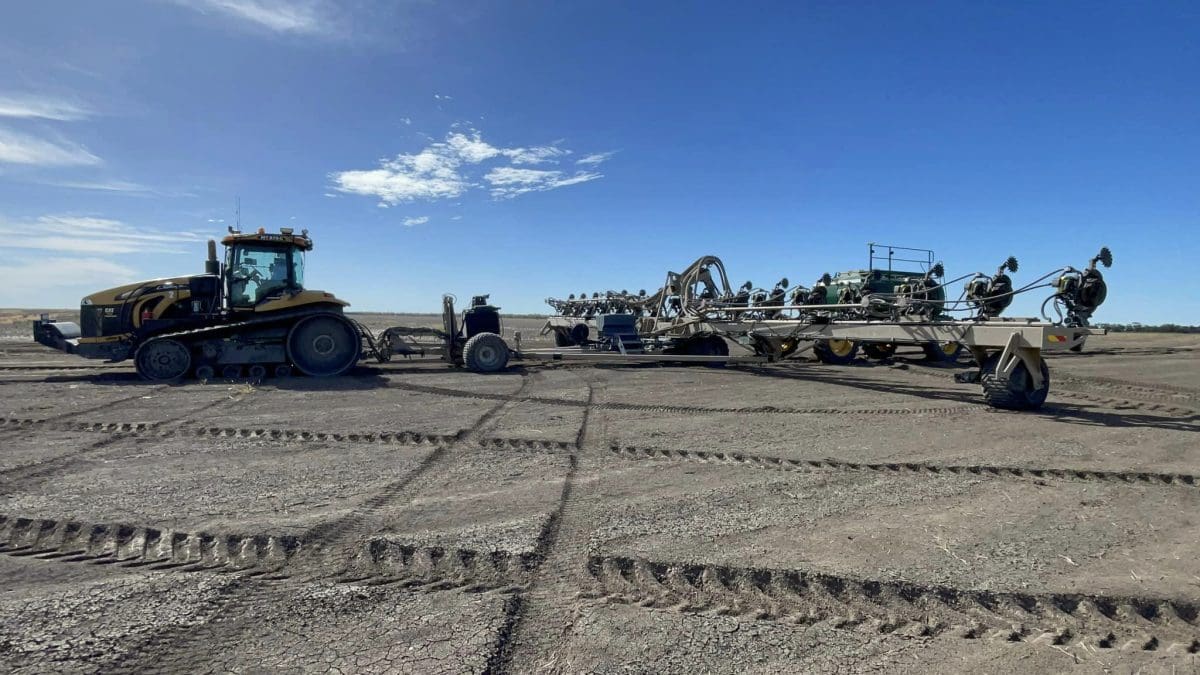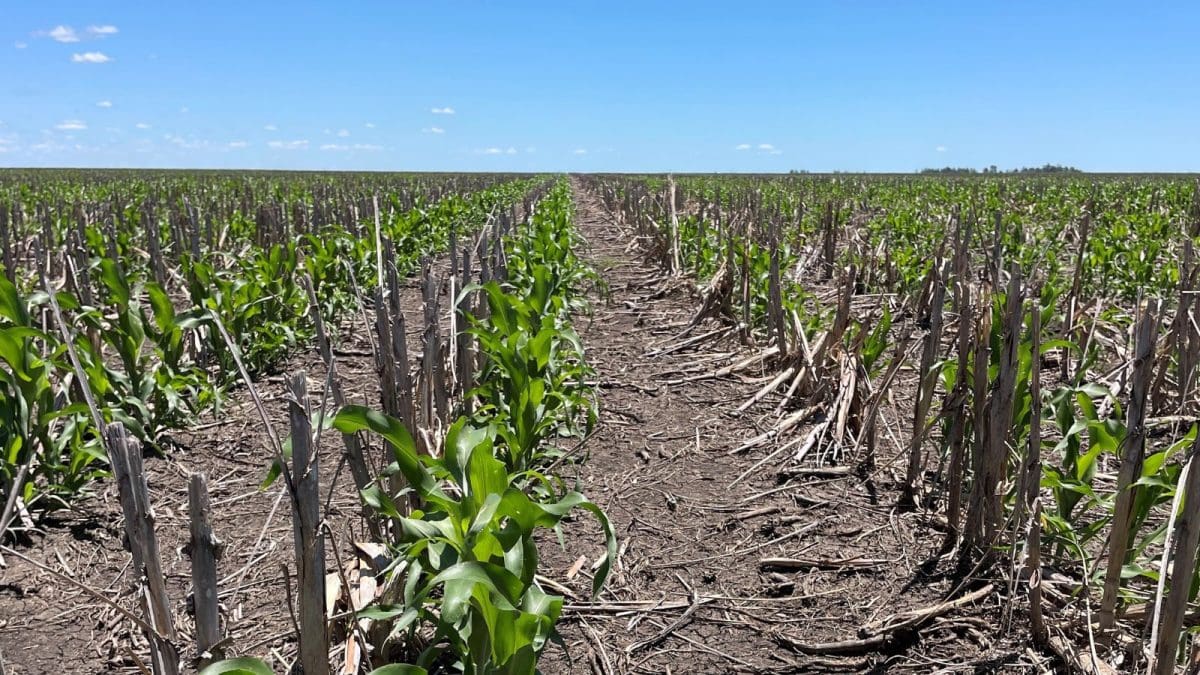
Sorghum planting is underway in parts of New South Wales, with Moree’s Beefwood/Kurstjens Farming just finishing 3000-hectares. Photo: Beefwood/Kurstjens Farming
FLOODING and later-than-average paddock preparation have delayed sorghum planting in most areas, with southern Queensland growers leading New South Wales on progress to date.
Attractive prices and strong water availability has meant that cotton is competing with sorghum for area.
However, at this stage, sorghum hectares are still expected to reach average levels.
If rain falls at the optimum times, there could also be an opportunity for late-planted or double-cropped sorghum in northern NSW and southern Queensland, that could work to bump up the final tonnage.
Southern Queensland advanced
Planting of the early sorghum is progressing well in the Darling and Eastern Downs, according to AgForce Grains president and Warra grower Brendan Taylor.
“Some of the very early sorghum that was planted in late September is very close to coming out in head, and it looks absolutely magnificent,” Mr Taylor said.
“Then there is, depending on where you live, varying degrees of maturity from just planted to the six-inches high sort of stuff.”
Pioneer Seeds portfolio manager Rob Johnston said he believed 70-80 per cent of sorghum has been planted on the Downs.
He said this is based on “the area expected for an average year”.
“There could still be an opportunity, after people harvest their winter crop and if we get a bit more rain, they could double crop some of that back into summer to change the rotation,” Mr Johnston said.
More rain needed
While November is not considered optimal time to plant, Mr Taylor said there will be some sown because the rain has eased, and people can get on to paddocks.
“There would be people trying to plant now.
“The rule book is out the window nowadays; you do what you can when you can.”
He said after the prohibitive flooding and prolonged rainfall over the past year, in a “bizarre” twist, many sorghum growers were now looking for rain to sure up their crops.
“Believe it or not, since we have had those couple of weeks of dry weather and a couple of horror westerly wind days, the surface has dried out.
“It is almost too dry to plant and people are looking for more rain.”
Elders Rural Dalby agronomist Millie Bach said, while some may keep planting, most growers who are yet to sow, will wait for November to pass.
“We will probably see a few people back off now,” Ms Bach said.
“We probably won’t get many plant until…later December and January just to keep the sorghum flowering out of that heat window.”

A flourishing sorghum crop planted at Bowenville in the Darling Downs. Photo: Ben Thrift, Pioneer Seeds
Cotton takes over hectares
Ms Bach said she has seen growers in the Dalby region switch to cotton due to the strong market and seasonal conditions.
She said this will have a slight impact on the overall area planted.
“I don’t think sorghum is going to be out of this world.
“I think it will still be an average year; cotton will soak up a fair bit this year just because we have full profile and a good seasonal outlook.”
New South Wales
B&W Rural agronomist based in Moree, Brad Donald said he has seen a similar move towards cotton over other summer crops in his region.
“There is a huge chunk of cotton going in over sorghum, but there has been sorghum going in,” Mr Donald said.
“The cotton price has been very good over the last couple of years, so it is quite attractive over sorghum.”
He said NSW was yet to see a huge amount of sorghum be planted due to flooding and the delay in paddock preparation, so the ultimate crop size and quality was still unclear.
“There has definitely been a delayed planting with the sorghum.
“There are a few early crops, but most has been planted in the last two or three weeks.”
He said these early crops have appeared to handle conditions “quite well”.
“It was challenging getting it established, but it is still alive.”
Also located in Moree, largescale cropping operation Beefwood/Kurstjens Farming has just finished sowing 3000 hectares of sorghum as they work to complete the late winter harvest.
Beefwood/Kurstjens Farming manager Glenn Coughran said flooding and waterlogged paddocks pushed the operation about a month behind schedule.
Despite this, and a planting hampered by bogged equipment, he is positive about the prospects of the sorghum crop.
“Everything is looking good,” Mr Coughran said.
“We have a full profile and a good outlook, so we are pretty optimistic about it.”
On the Liverpool Plains, Hunt Ag Solutions principal Jim Hunt said he predicted only 30-40pc of the dedicated sorghum areas have been planted.
He said there was no crop sown in October, with all the sorghum planted in November.
“It has dried up, but we are only starting to get on paddocks,” Mr Hunt said.
“Some paddocks still need another two weeks to dry before we can get on them and then we have to get them sprayed and in order.”
Mr Hunt said growers still have until mid-December to plant within the optimum window.
He said he expected the area planted to rise to over 90pc by the time the window closes.
“It will keep going; every day we are getting more and more sown.”
North looks for rain
Mr Donald said, like those in southern Queensland, many of his clients are now hoping for some rainfall to kick off the November-planted crops.
“It is drying out fast, so people are starting to look for the 15-20mm of rain.”
He said earlier rainfall and flooding has impacted the condition of the surface soil, making it less favourable as it dries out.
“The surface soil is quite hard as well from all the rain and the flooding.
“It is compacted pretty hard, so the general tithe of the soil is quite poor.”
Central Queensland
In Central Queensland, only a few growers have planted sorghum crops as the region’s traditional optimum sowing window is in January and February.
Mr Johnston said there has been good early interest from growers in this region and prospects are looking positive.
“There will be a very little early plant in Central Queensland, but really the season doesn’t open until mid to end of January and early February.
“We still have supply so…for those Central Queensland growers we can certainly supply the grain sorghum market with seed if growers still need stocks.”
Crop volumes predictions
In the ABARES Crop Report released in September, total grain sorghum production for 2022-23 was pegged at 2.6 million tonnes (Mt), the fourth highest on record.
This is mainly from Queensland, at 1.794Mt, followed by NSW with 836,000 tonnes.
Victoria and Western Australia are also expected to produce small volumes of grain sorghum.
These predictions will be updated when ABARES releases the last Crop Report for the year on December 6.
Grain Central: Get our free news straight to your inbox – Click here

HAVE YOUR SAY